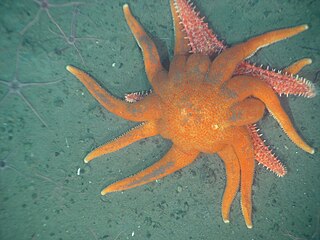
Murex is a genus of medium to large sized predatory tropical sea snails. These are carnivorous marine gastropod molluscs in the family Muricidae, commonly called "murexes" or "rock snails".

A salp or salpa is a barrel-shaped, planktonic tunicate. It moves by contracting, thus pumping water through its gelatinous body, one of the most efficient examples of jet propulsion in the animal kingdom. The salp strains the pumped water through its internal feeding filters, feeding on phytoplankton.

Strombus is a genus of medium to large sea snails, marine gastropod molluscs in the family Strombidae, which comprises the true conchs and their immediate relatives. The genus Strombus was named by Swedish Naturalist Carl Linnaeus in 1758. Around 50 living species were recognized, which vary in size from fairly small to very large. Six species live in the greater Caribbean region, including the queen conch, Strombus gigas, and the West Indian fighting conch, Strombus pugilis. However, since 2006, many species have been assigned to discrete genera. These new genera are, however, not yet found in most textbooks and collector's guides.

Tube-dwelling anemones or ceriantharians look very similar to sea anemones but belong to an entirely different subclass of anthozoans. They are solitary, living buried in soft sediments. Tube anemones live inside and can withdraw into tubes, which are composed of a fibrous material made from secreted mucus and threads of nematocyst-like organelles known as ptychocysts. Ceriantharians were formerly classified in the taxon Ceriantipatharia along with the black corals but have since been moved to their own subclass, Ceriantharia.

The Valvatida are an order of starfish in the class Asteroidea, which contains 695 species in 172 genera in 17 families.

Neritidae, common name the nerites, is a taxonomic family of small- to medium-sized saltwater and freshwater snails which have a gill and a distinctive operculum.

Corallimorpharia is an order of marine cnidarians closely related to stony or reef building corals (Scleractinia). They are mostly tropical, with a narrow column topped with a wide oral disc. The tentacles are usually short or very short, arranged in rows radiating from the mouth. Many species occur together in large groups. In many respects, they resemble the stony corals, except for the absence of a stony skeleton.
Cycloteuthis sirventi is a species of squid in the family Cycloteuthidae, of which it is the most common. It is possible that C. akimushkini is a junior synonym of C. sirventi. The species occurs in the tropical to polar western Atlantic Ocean.

Gemmula, common name the gem turrids, is a genus of sea snails, marine gastropod mollusks in the family Turridae, the turrids.

Turris is a genus of sea snails, marine gastropod mollusks in the family Turridae, the turrids.

Raphitoma is a genus of sea snails, marine gastropod mollusks in the family Raphitomidae.

Cochlespira is a genus of sea snails, marine gastropod mollusks in the family Cochlespiridae.

Oenopota is a genus of sea snails, marine gastropod mollusks in the family Mangeliidae.

Agathotoma is a genus of minute sea snails, marine gastropod mollusks or micromollusks in the family Mangeliidae.

Calliotropis is a genus of sea snails, marine gastropod mollusks in the family Eucyclidae.

Eulithidium is a genus of small colorful sea snails, marine gastropod mollusks in the family Phasianellidae, the pheasant shells.
Trachypollia is a genus of sea snails, marine gastropod mollusks in the family Muricidae, the murex snails or rock snails.

Rissoa is a genus of minute sea snails, marine gastropod mollusks or micromollusks in the family Rissoidae.

Cichliformes is an order of fishes, previously classifies under the order Perciformes but now many authorities consider it to be an order within the subseries Ovalentaria.

















